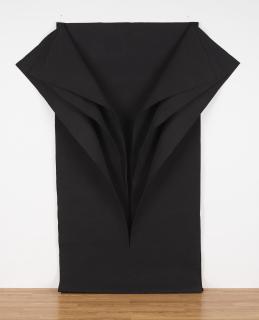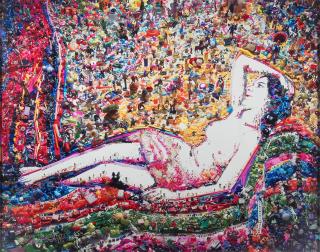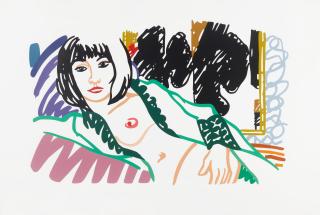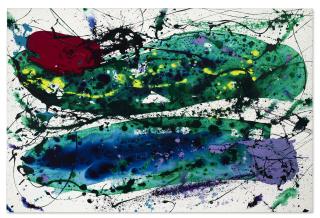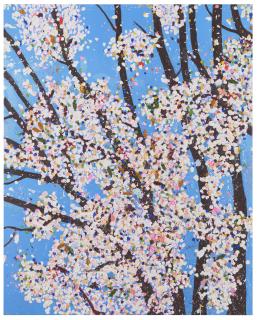Robert Morris American, 1931 - 2018
The artist Robert Morris
- One of the most important representatives of Minimal Art.
- Was significantly involved in the development of Earthworks (Land Art).
- His famous work »Observatorium« can be seen publicly in Lelystad, the Netherlands.
Officially, Robert Morris is considered one of the main representatives of Minimal Art. In the 1960s, he was also open to the performance scene and developed his own concepts on the so-called Earthworks - installations that involve the environment and do not commit themselves to a material. Morris also experimented with ephemeral (short-lived) materials during this period.
Morris was born in Kansas City in 1931 and initially attended the Kansas City Art Institute and the University of Kansas City there. His academic career ended late, and he changed teaching institutions several times: after moving to San Francisco in 1950, he went to the California School of Fine Arts, and from 1953 finally to Reed College in Portland, 1000 kilometers to the north. Morris finally completed his master's degree in art history at Hunter College in New York City in 1963.
His working methods are as varied as Morris's education. In his own statements in 1970, the artist attributed this to his unbiased exploration of materials and processes. In 1959, he left Abstract Expressionism behind before a photograph showing Jackson Pollock at work led him to performance art.
His first performance works dealt with bodies in space: he makes columns topple over, and he revisits this idea in his first minimalist sculpture, Two Columns (1961). Between 1963 and 1970, Morris' work also shifted to the film and dance stage: he composed and staged dance pieces as well as film and theater projects.
The artist arrived at his famous Earthworks beginning in 1966, when his plan was to formally stretch the concept of Minimal Art - away from fixed materials and toward more variability. At this point came the ephemeral substances. Morris pursued Land Art all the way to pipes buried underground: in 1967, Steam Cloud emitted steam from pipes - first in the form of an outdoor installation, and two years later at the Corcoran Gallery in Washington, also as an indoor installation.
One of his best-known Earthworks is Observatory (1977), located in Lelystad in the Netherlands. Made of wood, earth, steel, and granite, the installation resembles crop circles in aerial views and is said to be modeled after a reconstructed Stonehenge. Morris died in November 2018 in Kingston, New York.
Der Künstler Robert Morris
- Einer der wichtigsten Vertreter der Minimal Art.
- War wesentlich an der Entwicklung von Earthworks (Land-Art) beteiligt.
- Sein bekanntes Werk »Observatorium« ist öffentlich im niederländischen Lelystad zu sehen.
Offiziell gilt Robert Morris als einer der Hauptvertreter der Minimal Art. In den 1960er Jahren zeigte er sich auch offen gegenüber der Performance-Szene und entwickelte eigene Konzepte zu den sogenannten Earthworks – Installationen, die die Umwelt miteinbeziehen und sich nicht auf ein Material festlegen. Morris experimentierte in dieser Zeit auch mit ephemeren (kurzlebigen) Stoffen.
Morris wurde 1931 in Kansas City geboren und besuchte dort zunächst das Kansas City Art Institute und die University of Kansas City. Seine akademische Laufbahn endete erst spät, er wechselte das Lehrinstitut mehrfach: Nach seinem Umzug nach San Francisco 1950 ging er zur California School of Fine Arts, ab 1953 schließlich aufs Reed College ins 1000 Kilometer nördlicher gelegene Portland. Seinen Master in Kunstgeschichte absolvierte Morris schließlich 1963 am Hunter College in New York City.
So vielseitig wie Morris Ausbildung fächern sich auch seine Arbeitsweisen auf. Der Künstler selbst führte dies in eigenen Aussagen 1970 auf seine unvoreingenommene Auseinandersetzung mit Materialien und Verfahrensweisen zurück. 1959 ließ er den Abstrakten Expressionismus zurück, ehe ihn eine Fotografie, die Jackson Pollock bei der Arbeit zeigt, zur Performance-Kunst verleitete.
Seine ersten Performance-Arbeiten beschäftigten sich mit Körpern im Raum: Er lässt Säulen umstürzen und greift diese Idee auch bei seiner ersten minimalistischen Skulptur Two Columns (1961) wieder auf. Zwischen 1963 und 1970 verlagert sich Morris’ Arbeit auch auf die Film- und Tanzbühne: Er komponierte und inszenierte Tanzstücke sowie Film- und Theaterprojekte.
Zu seinen berühmten Earthworks kommt der Künstler ab 1966. Sein Plan war es, den Begriff der Minimal Art formal zu dehnen – weg von fixen Materialien hin zu mehr Variabilität. An dieser Stelle kamen auch die ephemeren Substanzen. Die Land-Art verfolgte Morris bis hin zu unterirdisch verlegten Rohren: 1967 stieß die Steam Cloud Dampf aus den Rohren aus – zuerst in Form einer Außeninstallation, zwei Jahre später in der Corcoran Gallery in Washington auch als Inneninstallation.
Eines seiner bekanntesten Earthworks ist Observatorium (1977), das sich in Lelystad in den Niederlanden befindet. Die aus Holz, Erde, Stahl und Granit bestehende Installation erinnert in Luftaufnahmen an Kornkreise und soll einem rekonstruierten Stonehenge nachempfunden sein. Morris starb im November 2018 in Kingston, New York.
Robert Morris in a nutshell
Felt Piece is a work of art by Robert Morris from 1968. It consists of two sheets of paper, which the artist has written on with flick pen. Felt Piece is reminiscent of a fleeting sketch. The work is in the Museum of Modern Art (MoMA) in New York.
Untitled (Tangle) from 1967 is a work by Robert Morris that is in the Museum of Modern Art (MoMA) in New York. It is made of felt, its dimensions are variable, approximately measuring 9' 8" x 8' 10" x 58" (296.7 x 269.3 x 147.4 cm). The felt is arranged into ribbons. In the museum's image, they evoke associations with chaotically folded tape. At the same time, it is the artist's most expensive work to date (2022).
The highest price was achieved by the work Untitled (1967). The Phillips auction house in New York auctioned it in 2010 at a price of 1,258,500 US dollars (at that time about 965,404 €). Some of Robert Morris's drawings rank in the mid- to upper four-figure range, while sculptures are more likely to be in the five-figure price segment.
Häufige Fragen zu Robert Morris
Das Felt Piece ist ein Kunstwerk von Robert Morris aus dem Jahr 1968. Es besteht aus zwei Blatt Papier, die der Künstler mit Flizstift beschriftet hat. Felt Piece erinnert an eine flüchtige Skizze. Die Arbeit befindet sich im Museum of Modern Art (MoMA) in New York.
Untitled (Tangle) von 1967 ist eine Arbeit von Robert Morris, die sich im Museum of Modern Art (MoMA) in New York befindet. Sie besteht aus Filz, ihre Abmessungen sind variabel, ungefähr misst sie 9' 8" x 8' 10" x 58" (296,7 x 269,3 x 147,4 cm). Das Filz ist zu Bändern arrangiert. Auf der Abbildung des Museums wecken sie Assoziationen zu chaotisch zusammengelegtem Tonband. Gleichzeitig ist es die bisher (2022) teuerste Arbeit des Künstlers.
Den höchsten Preis erzielte die Arbeit Untitled (1967). Das Auktionshaus Phillips in New York versteigerte sie 2010 zu einem Preis von 1.258.500 US-Dollar (damals etwa 965.404 €). Einige Zeichnungen von Robert Morris rangieren im mittleren bis oberen vierstelligen Bereich, während Skulpturen eher im fünfstelligen Preissegment angesiedelt sind.


